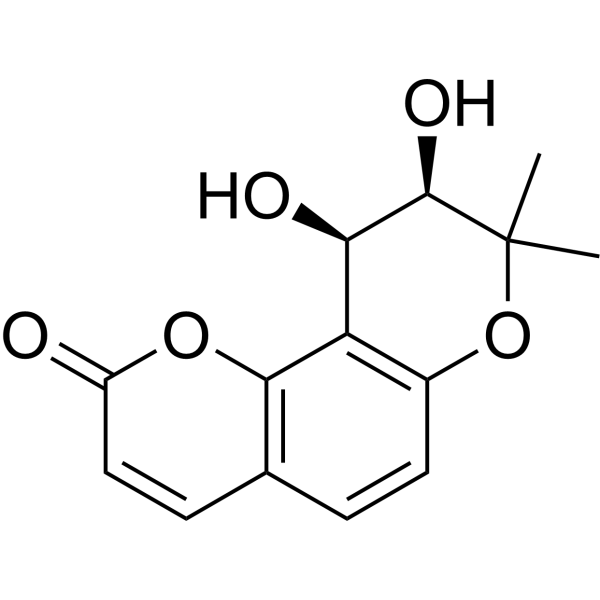
Khellactone
CAS No. 24144-61-4
Khellactone( —— )
Catalog No. M31498 CAS No. 24144-61-4
Khellactone shows antitumor activity,it can suppress the growth of NCI-H460 tumor cells. (+)-4'-cis-Khellactone and (+)-3'-cis-khellactone have antiplasmodial activities, they show notable inhibitory activity against -sensitive strains of with IC(50) values from 1.5 and 2.4 microM.
Purity : >98% (HPLC)
 COA
COA
 Datasheet
Datasheet
 HNMR
HNMR
 HPLC
HPLC
 MSDS
MSDS
 Handing Instructions
Handing Instructions
| Size | Price / USD | Stock | Quantity |
| 5MG | 414 | In Stock |


|
| 50MG | Get Quote | In Stock |


|
| 100MG | Get Quote | In Stock |


|
Biological Information
-
Product NameKhellactone
-
NoteResearch use only, not for human use.
-
Brief DescriptionKhellactone shows antitumor activity,it can suppress the growth of NCI-H460 tumor cells. (+)-4'-cis-Khellactone and (+)-3'-cis-khellactone have antiplasmodial activities, they show notable inhibitory activity against -sensitive strains of with IC(50) values from 1.5 and 2.4 microM.
-
DescriptionKhellactone shows antitumor activity,it can suppress the growth of NCI-H460 tumor cells. (+)-4'-cis-Khellactone and (+)-3'-cis-khellactone have antiplasmodial activities, they show notable inhibitory activity against -sensitive strains of with IC(50) values from 1.5 and 2.4 microM.
-
In Vitro——
-
In Vivo——
-
Synonyms——
-
PathwayOthers
-
TargetOther Targets
-
Recptor——
-
Research Area——
-
Indication——
Chemical Information
-
CAS Number24144-61-4
-
Formula Weight262.3
-
Molecular FormulaC14H14O5
-
Purity>98% (HPLC)
-
Solubility——
-
SMILES——
-
Chemical Name——
Shipping & Storage Information
-
Storage(-20℃)
-
ShippingWith Ice Pack
-
Stability≥ 2 years
Reference
molnova catalog



related products
-
Methyl 5-methylnicot...
Used as pharmaceutical intermediates.
-
Leucokinin III
Leucokinin III
-
Palmatine
Palmatine has been used in the treatment of jaundice, dysentery, hypertension, inflammation, and liver-related diseases.



 Cart
Cart
 sales@molnova.com
sales@molnova.com


